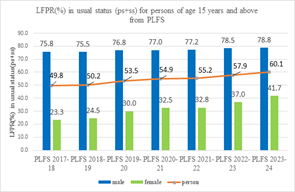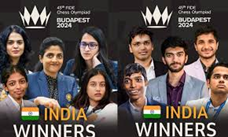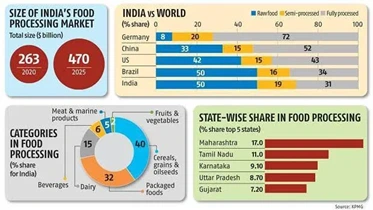Thursday, 26th September 2024
Sustainable Food Systems and India’s Trade Agreement
Why in the news ?
- Recently,”Sustainable Food Systems and India’s Trade Agreements” Policy was released by ICRIER to help develop a sustainable food system.
About the sustainable food system (SFS):
- This program provides stable, safe and nutritious food for whatever economic, social and environmental benefits. (See infographic)
Issues in SFS of India:
- Coordination gaps in government agencies: In the case of spices, for example, responsibilities were divided between APEDA, the Spices Committee and the Export Inspection Council.
- Lack of data and information in design/programming: lack of impact assessment.
- Differences in technology adoption: fragmented supply chains, lack of strong public-private partnerships in agriculture to transfer technology , and so on
- Trade-related issues: Periodic restrictions or excise duties, denial of export due to non-compliance with SPS standards.
SFS Eco-social Progress:
|
Economic Sustainability
|
Social Sustainability
|
Environmental Sustainability
|
Key suggestions:
- A Comprehensive vision document with specific objectives such as reduction of food waste, use of harmful chemicals.
- Simplify coordination between multiple regulators. such as a nodal agency for exports.
- Use field-to-fork probes. For example, ‘GrapeNet’ which manages the export of fresh grapes from India to the EU
- Reduce trade barriers by strengthening quality testing and certification.
- Implementation of best agricultural practices for example, e.g., International Year of Millets 2023
Source: ICRIER
Deeptech: Revolutionising the Future of Technology
Why in the news ?
- Recently, DRDO funded five high-value deep tech innovation projects, with each project having been allotted a maximum of ₹50 crore to promote indigenisation of defence products .
Key Characteristics of Deeptech:
- DeepTech is based on advanced scientific research and technology, which requires extensive research and development and deep knowledge of the underlying science
- Firms face high barriers to entry due to core competencies, capital requirements and complex development schedules.
- DeepTech addresses critical challenges in sectors such as healthcare, energy, manufacturing, and agriculture, delivering solutions that deliver economic benefits and social impact.
- Deeptech companies often require longer timelines due to rigorous testing and certification before products enter the market.
Challenges faced by Deeptech:
- Developing strong technological solutions requires significant investments in research, infrastructure and skilled talent, making it difficult for startups to raise funds.
- Technical, regulatory and market acceptance challenges must be overcome to bring new products to market.
- The demand for specialised skills in areas such as quantum computing and biotechnology exceeds the availability of trained workers.
- Extended promotion and approval periods may discourage investors seeking quick returns.
National Deeptech Startup Policy:
- About:
- It aims to support and promote deep technology startups, which leverage scientific and engineering innovations to address challenges in key sectors like healthcare, agriculture, energy, and manufacturing.
- Objectives of the Policy:
- Promoting Innovation: Support cutting-edge technologies through R&D, grants, and innovation hubs.
- Facilitating Access to Capital: Provide financial assistance, venture capital, and tax benefits to deep tech startups.
- Building Infrastructure: Establish incubators, accelerators, and test beds to bridge research and commercialization.
- Developing Skilled Talent: Strengthen educational programs and skill initiatives to create a talent pool in advanced tech fields.
- Streamlining Regulations: Simplify regulations, including IPR protection and export controls, for faster approvals.
DRDO to Fund Deep Tech Research for Military Use:
- Pioneering Initiative: DRDO is set to advance research in emerging military technologies, supported by a ₹1 lakh crore fund from the interim Budget.
- Indigenization and Innovation: The initiative aims to indigenize defence products and promote deep tech innovations in quantum computing, blockchain, and AI.
- High-Value Projects: DRDO has selected five projects, each with a funding cap of ₹50 crore, to reduce import dependency and enhance self-reliance in defence.
- DARPA-Inspired Model: The programme follows the US DARPA model, focusing on futuristic and disruptive technologies to revolutionise defence systems.
- Funding Approval: Defence Minister Rajnath Singh approved the funds, which will be managed through DRDO's Technology Development Fund (TDF) to engage private industry, MSMEs, and startups in military tech development.
|
UPSC Civil Services Examination, Previous Year Question (PYQ) Prelims: Q:1 Atal Innovation Mission is set up under the (2019)
Ans: (c) Mains: Q:1 COVID-19 pandemic has caused unprecedented devastation worldwide. However, technological advancements are being availed readily to win over the crisis. Give an account of how technology was sought to aid management of the pandemic. (2020) |
Source: TH
India-Indonesia: 75th Anniversary of Diplomatic Relations
Why in the news ?
- 8th India-Indonesia Foreign Office Consultations were held in New Delhi and commemorated 75 years of the establishment of diplomatic relations.
India-Indonesia Bilateral Relations:
- Cultural & Historical Ties: Indian epics, Hinduism, Buddhism, and Islam influenced Indonesia. Joint celebration of Bali Yatra festival & Swami Vivekananda Cultural Centre.
- Political Relations: Cooperation in Bandung Conference (1955) and Non-Aligned Movement (1961). Enhanced ties through 'Look East' and 'Act East' policies.
- G20 Engagement: Indonesia chaired G20 in 2022; India took over in December 2022, with active bilateral participation.
- Economic Relations: 2022-23 trade reached USD 38.85 billion. India imports coal, palm oil; exports petroleum, vehicles, and agricultural goods.
- Investment: Indian investment of USD 1,219 million (2000-2022) in 4,750 projects, with significant flows via Singapore.
- Blue Economy: SAGAR initiative of port infrastructure, particularly the Sabang port in Aceh, Indonesia. The deep seaport at Sabang will enhance India's strategic access to the Malacca Strait connectivity to the Andaman and Nicobar Islands.
- Digital & Technological Cooperation:Capacity-building platforms like ITEC (Indian Technical and Economic Cooperation Programme), and Technical Cooperation Scheme (TCS) of the Colombo Plan.
- Defence: Reinforced by the 2018 Defence Cooperation Agreement. Joint military exercise "Garuda Shakti" with Indian and Indonesian Special Forces.
Challenges in the relationship:
- Trade Imbalance: The balance of trade favours Indonesia due to India's large imports of palm oil and coal.
- Unrealized trade potential: As per some estimates bilateral trade potential is US$ 61 billion, 33% higher than current trade.
- Dominance of China: Indonesia has accepted substantial Chinese investment under the Belt and Road, which has raised concerns.
- Lack of connectivity: Limited direct air connectivity and visa issues have hindered greater people-to-people interactions.
Way Forward:
- Tourism Diplomacy: Establish 'RICH' (Religious, Cultural, History) themed tourism to boost people-to-people exchanges.
- Enhancing Trade: Accelerate Comprehensive Economic Partnership Agreement (CEPA) to overcome trade and investment barriers.
- Strategic Interfaces: Encourage Indonesia to join initiatives like International Solar Alliance, Coalition for Disaster Resilient Infrastructure, and Global Biofuels Alliance.
- Regional Cooperation: Strengthen engagement through multilateral platforms such as ASEAN Regional Forum, IORA, and IONS.
Source: AIR
Storms brewing in East, South China seas
Why in the news ?
- In recent years, maritime East Asia has witnessed escalating power struggles, with China claiming Japan-controlled Senkaku/Diaoyu Islands in the East China Sea, sparking repeated tensions.
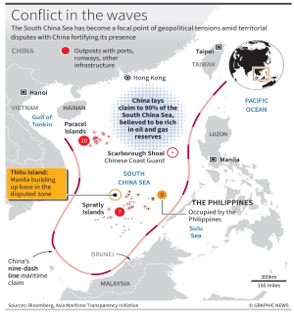
Significance for China:
- Geopolitical Control: Both seas are vital for China’s defence and military positioning, forming a buffer against external threats as part of its "first island chain" defence strategy.
- Territorial Claims: China considers the ECS and SCS integral to its sovereignty, with disputes over islands like Diaoyu/Senkaku in the ECS and various islets in the SCS. The 2019 Defence White Paper emphasises these territories as part of China.
- Trade Routes: The SCS, a major maritime corridor, sees about $3.4 trillion in annual trade, giving China leverage over international shipping routes.
- Fisheries and Resources: Rich in fish stocks, the ECS and SCS are crucial for China's food security and economy, providing livelihoods for millions in neighbouring countries.
- Energy Resources: The SCS is believed to hold significant oil and natural gas reserves, essential for China’s growing energy demands and for other countries reliant on these resources.
Significance for Other Countries:
- Key Maritime Route: Major trade routes in East Asia pass through these seas, with the Taiwan Strait as a critical choke point.
- Vital for Digital Economy: The region contains essential undersea cables for the global digital economy.
- Vital for Energy Security: In 2023, approximately 10 billion barrels of petroleum and 6.7 trillion cubic feet of liquefied natural gas transited the SCS, alongside vast untapped reserves.
- Global Security: The ECS and SCS are flashpoints for potential conflict, drawing global attention, particularly from the U.S., which conducts Freedom of Navigation Operations (FONOPs) to counter China’s claims.
Posture Taken by China in This Region:
- East China Sea Tensions:
- China contests Japan's control over the Senkaku/Diaoyu Islands, resulting in crises, including a 2010 fishing captain incident and Japan's 2012 nationalisation.
- Although tensions eased, 2023 saw heightened Chinese Coast Guard activity near the islands, straining relations with South Korea, Taiwan, and Japan.
- South China Sea Power Asymmetry: China’s increased military presence against countries like Vietnam, Malaysia, the Philippines, and Brunei, utilising "grey zone" operations.
- Philippines-China Tensions: Since 2022, tensions have escalated, particularly around Second Thomas Shoal and Sabina Shoal, with China disrupting Philippine resupply missions and ramming smaller vessels, raising miscalculation risks.
- Strategic Alignment and Legal Rejection: In July 2024, China conducted joint naval exercises with Russia, reinforcing geopolitical alliances. Despite a 2016 Permanent Court of Arbitration ruling rejecting its claims.
Way Forward:
- Strengthening Maritime Partnerships: India should bolster strategic maritime alliances in the Indo-Pacific through forums such as the Quad (India, U.S., Japan, and Australia) and ASEAN to promote a free and open Indo-Pacific.
- Economic and Infrastructure Diplomacy: India can enhance its economic footprint by leveraging initiatives like SAGAR (Security and Growth for All in the Region) to invest in infrastructure, connectivity, and capacity-building projects in Southeast Asian nations.
|
UPSC Civil services examination PYQ Mains Q:1 South China Sea has assumed great geopolitical significance in the present context. Comment. (2016) |
Source: TH
Exostoma sentiyonoae
Why in the news ?
- Recently, A new species of glyptosternine catfish- Exostoma sentiyonoae, has been discovered in the Dzuleke River, a tributary of the Barak River in Nagaland.
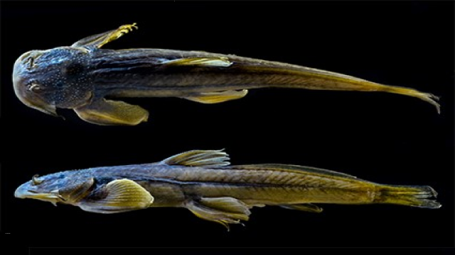
About Exostoma sentiyonoae:
- Features: Including an adipose fin on the upper procurrent caudal-fin rays, tubercles on the dorsal-fin spine, a slender head, a long dorsal-adipose distance, small eyes, and 41 vertebrae.
- Distinction from Congeners: Differentiated from E. berdmorei and E. gaoligongense in Myanmar and Thailand's Salween drainage.
- Comparative Analysis: Shorter dorsal-fin base, longer dorsal-adipose distance, and smaller eyes distinguish it from E. berdmorei; shorter pectoral-pelvic distance.
- Biodiversity Significance: Marks the fourth Exostoma species described from the Barak drainage, highlighting regional biodiversity.
- Geographical Discovery: First known member of this genus discovered in the Dzuleke River, Nagaland.
The Bark system:
- About: The Barak is the second largest river in Northeast India after the Brahmaputra.
- Origin: it originates as a small stream amidst the lofty hills covered by thick forests of Liyai village in the Poumai territory of Manipur.
- Length: It has a length of about 900 km of which, 564 km fall in India.
- Drainage:
- The river runs through Manipur, Nagaland, Mizoram, Assam in India and Bangladesh.
- The stream is joined by Deirii stream and Makhan stream as it flows down south through the Biiso valley.
- The Barak flows southwards into the Zeme, Liangmai and Rongmei territories of Manipur and Nagaland.
- Finally, Barak flows into Bangladesh to join the Brahmaputra and Ganga.
Source: MT
Central Silk Board
Why in the news ?
- Recently, the Union Minister of Textiles unveiled the Commemoratory coin, celebrating the Platinum Jubilee of the Central Silk Board (CSB) at Mysuru.
What is the Central Silk Board?
- About:
- Central Silk Board is a Statutory Body established in 1948, by an Act of Parliament.
- It functions under the administrative control of the Union Ministry of Textiles, Government of India.
- It comprises 39 members appointed as per the powers and provisions conferred by Sub-Section 3 of Section 4 of the CSB Act 1948, for a period of 3 years.
- Functions:
- It advises the Central Government on production, supply, distribution, trade, and commerce of silk-worm seeds including exports and imports.
- It has established 6 Regional Offices at New Delhi, Mumbai, Kolkata, Hyderabad, Bhubaneswar and Guwahati.
- Headquarters: Bengaluru
- Silk Production in India
- India is the only country producing all the five known commercial silks, namely, mulberry, tropical tasar, oak tasar, eri and muga.
- India is the second largest producer with a share of global production jumping from 6% in 1949 to 42% in 2023.
Source: PIB
PARAM Rudra Supercomputers
Why in the news ?
- Recently, the Prime Minister of India virtually launched three Param Rudra Super Computing Systems and a High Performance Computing (HPC) system for weather and climate research.
About PARAM Rudra Supercomputer:
- Purpose: Designed to address complex computational challenges in scientific and engineering fields.
- Development: Three PARAM Rudra supercomputers have been developed indigenously under the National Supercomputing Mission.
- Deployment Locations: They are installed in Delhi, Pune, and Kolkata.
- Pune: The Giant Metre Radio Telescope (GMRT) will utilise the supercomputer to study Fast Radio Bursts (FRBs) and other astronomical phenomena.
- Delhi: The Inter University Accelerator Centre (IUAC) will enhance research in material science and atomic physics.
- Kolkata: The S N Bose Centre will employ supercomputing for advanced research in physics, cosmology, and earth sciences.
What is a High-Performance Computing (HPC) System?
- Purpose: Designed for weather and climate research.
- Location: Established at the Indian Institute of Tropical Meteorology (IITM) in Pune and the National Center for Medium Range Weather Forecast (NCMRWF) in Noida.
- Naming: The new HPC systems are called 'Arka' and 'Arunika,' symbolising their connection to the Sun.
- Significance: Improve the accuracy and lead time of predictions related to tropical cyclones, heavy precipitation, thunderstorms, hailstorms, heat waves, droughts, and other critical weather phenomena.
Key Facts about the National Supercomputing Mission:
- Launch: Initiated in 2015 to provide supercomputing infrastructure for academia, researchers, MSMEs, and startups.
- Objective: Aims to establish a network of advanced computing systems across India.
- Collaboration: Jointly executed by the Ministry of Electronics and Information Technology (MeitY) and the Department of Science and Technology (DST).
- Implementation: Managed by the Centre for Development of Advanced Computing (C-DAC) in Pune and the Indian Institute of Science (IISc) in Bengaluru.
Source: PIB
GlobE Network
Why in the news ?
- Recently, India has been elected to the fifteen-member steering committee of the Global Operational Network of Anti-Corruption Law Enforcement Authorities (GlobE Network).
About GlobE Network:
- About: Launched in June 2021 under the G20 framework of the United Nations General Assembly Special Session on Anti-Corruption (UNGASS).
- Members: It currently has 121 member states and 219 authorities worldwide.
- Aim: To facilitate international cooperation in the fight against cross-border corruption and economic crime, and to support asset recovery efforts.
- Power: The network enables global organisations to access crime reporting, best practices, and joint anti-corruption strategies.
- Significance of India’s Election: It actively supports global anti-corruption efforts, leverages its expertise in corruption prevention, and gives it a leadership role to the forefront internationally, especially after the 2023 G20 Presidency.
- India Department: India’s Central Bureau of Investigation (CBI) and Enforcement Directorate (ED) are part of the network, with the Union Ministry of Home Affairs (MHA).
Source: TH
Exploring the Prospects of One Nation One Election
Context:
- A high-level committee chaired by former President Ram Nath Kovind, the idea of "One Nation, One Election(ONOE)" has once again gained significant traction in India’s political landscape.
- It could potentially lower the costs associated with conducting multiple elections and streamline the electoral process, promoting a sense of stability and predictability in governance.
What is One Nation, One Election (ONOE)?
- About: ONOE proposes conducting simultaneous elections for the Lok Sabha and all State Legislative Assemblies in India, potentially including local body elections (municipalities and panchayats).
- Objective: To synchronise electoral cycles across different levels of government, allowing elections to occur concurrently or within a specified timeframe, necessitating constitutional amendments and changes to election-related laws.
- Historical Context: India held synchronised elections from 1951 to 1967. However, this practice declined due to political factors, premature dissolutions, and instability in the 1960s, leading to diverging election cycles.
Advantages of One Nation, One Election:
- Cost Reduction: The cost of Lok Sabha elections rose from ₹10.5 crore in 1951-52 to ₹50,000 crore in 2019,ECI could also reduce operational costs through streamlined processes.
- Governance Continuity: Fewer elections could reduce "policy paralysis" caused by short-term electoral strategies and the Model Code of Conduct, alleviating resource strain and curbing corruption among political parties.
- Reduced Disruptions: Less frequent elections would minimise disruptions to public life, benefiting educational institutions used as polling stations.
- Increased Voter Participation: Simultaneous elections may reduce "election fatigue," potentially leading to higher voter turnout and engagement.
- Streamlined Campaigns: Political parties could benefit from focused campaign efforts, enabling smaller parties to compete more effectively.
- Economic Benefits:
- GDP growth could increase by 1.5 percentage points in the year following simultaneous elections, with a potential 1.28% rise in fiscal deficit and a 17.67% increase in public spending.
- Also reduce black money influx and political donation pressures, as evidenced by ₹10,000 crore seized during the 18th Lok Sabha elections.
- Improved Election Monitoring: The concentrated nature of simultaneous elections might facilitate enhanced election monitoring.
- Enhanced Administrative Efficiency: Holding joint polls can improve administrative efficiency by reducing governance downtime and freeing security resources typically involved in the election process.
Challenges of One Nation, One Election (ONOE):
- Threat to Federalism: This could diminish the representation of regional voices and local concerns, making it harder for smaller regional parties to compete against well-funded national parties, thereby reducing political diversity.
- Logistical Challenges: Implementing ONOE would require a significant investment in Electronic Voting Machines (EVMs) and Voter Verifiable Paper Audit Trail (VVPAT) machines, estimated at ₹9,284.15 crore.
- Constitutional Concerns: Special majority and ratification by more than half of India's states, potentially infringing on the powers of the President and state governors and raising questions about the balance of power in India’s parliamentary democracy.
- Governance Vacuums: To prolonged periods of President's Rule in states, creating governance vacuums and leaving citizens without adequate representation during critical times.
- Reduced Accountability: Fewer elections could diminish the vigilance of representatives, limiting voters' opportunities to express dissatisfaction.
- Pressure on Election Machinery: Any systemic failures or irregularities could undermine public trust in the electoral process and institutions.
Way Forward:
- Building Consensus: Engage political parties and states in open dialogue to address concerns and gain support for ONOE.
- Constitutional Amendments: Amend the Constitution, the Representation of the People Act 1951, and parliamentary rules to facilitate synchronised elections.
- Aligning Assembly Terms with Lok Sabha: Consider aligning assembly terms with Lok Sabha elections to streamline the electoral process.
- Investment in Infrastructure: Invest in electoral infrastructure, including EVMs, VVPATs, and trained personnel, for effective implementation.
- Legal Framework for Contingencies: Develop legal frameworks to address potential issues like no-confidence motions or premature dissolutions during simultaneous elections.
- Awareness and Voter Education: Educate voters about the benefits and challenges of ONOE to ensure informed participation.
|
UPSC Civil Services Examination Previous Year Question (PYQ) Prelims Q1. Consider the following statements: (2020)
Which of the statements given above is/are correct?
Answer: (d)
Q2. Consider the following statements: (2017)
Which of the statements given above is/are correct?
Answer: (d) Mains Q.1 ‘Simultaneous election to the Lok Sabha and the State Assemblies will limit the amount of time and money spent in electioneering but it will reduce the government’s accountability to the people’ Discuss. (2017) |
Source: TOI
Share the article
Edukemy’s Current Affairs Quiz is published with multiple choice questions for UPSC exams
MCQ
Get Latest Updates on Offers, Event dates, and free Mentorship sessions.

Get in touch with our Expert Academic Counsellors 👋
FAQs
UPSC Daily Current Affairs focuses on learning current events on a daily basis. An aspirant needs to study regular and updated information about current events, news, and relevant topics that are important for UPSC aspirants. It covers national and international affairs, government policies, socio-economic issues, science and technology advancements, and more.
UPSC Daily Current Affairs provides aspirants with a concise and comprehensive overview of the latest happenings and developments across various fields. It helps aspirants stay updated with current affairs and provides them with valuable insights and analysis, which are essential for answering questions in the UPSC examinations. It enhances their knowledge, analytical skills, and ability to connect current affairs with the UPSC syllabus.
UPSC Daily Current Affairs covers a wide range of topics, including politics, economics, science and technology, environment, social issues, governance, international relations, and more. It offers news summaries, in-depth analyses, editorials, opinion pieces, and relevant study materials. It also provides practice questions and quizzes to help aspirants test their understanding of current affairs.
Edukemy's UPSC Daily Current Affairs can be accessed through:
- UPSC Daily Current Affairs can be accessed through Current Affairs tab at the top of the Main Page of Edukemy.
- Edukemy Mobile app: The Daily Current Affairs can also be access through Edukemy Mobile App.
- Social media: Follow Edukemy’s official social media accounts or pages that provide UPSC Daily Current Affairs updates, including Facebook, Twitter, or Telegram channels.

